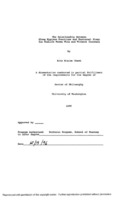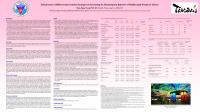The Relationship Between Sleep Hygiene Practices and Nocturnal Sleep for Midlife Women with and without Insomnia
View File(s)
Visitor Statistics
Visits vs Downloads
Visitors - World Map
Top Visiting Countries
| Country | Visits |
|---|
Top Visiting Cities
| City | Visits |
|---|
Visits (last 6 months)
Downloads (last 6 months)
Popular Works for Cheek, Rita E. by View
| Title | Page Views |
|---|
Popular Works for Cheek, Rita E. by Download
| Title | Downloads |
|---|
View Citations
Citations
In this study sleep hygiene practices and perceived and somnographic sleep indicators were analyzed for 92 women with insomnia and 29 women with no insomnia ages 40 to 55. Women recorded practices and perceptions in diaries during 6 days of polysomnographic sleep monitoring. Self-reported practices included smoking cigarettes, drinking alcohol, drinking caffeine, and exercising. Optimal sleep hygiene practices include abstaining from tobacco and alcohol or caffeine intake while getting regular exercise and maintaining a regular schedule for sleeping. Perceptions included sleep onset latency, awakenings, restfulness after sleeping, and sleep quality. Somnographic measures included bedtime, latency to Stages 1 and 2, Stage 0, and getting up time. Regular bedtimes and regular getting up times were defined as less than 30 minutes variation day to day. Women in both groups reported similar practices except for differences in alcohol and caffeine intake. More women with insomnia (52%) than without insomnia (31%) abstained from alcohol each day (95% CI =.01,.41). Less than 10% in both groups reported drinking alcohol everyday. More than 80% in both groups reported drinking one or more servings of caffeine per day, but women with insomnia averaged one less serving of caffeine per day than women without insomnia (p $<$.05). Few women in either group reported smoking ($<$10%). Less than 25% reported 30 minutes of exercise each day, although about one-half of each group reported exercising an average of 30 minutes per day. Very few women had regular bedtimes ($<$5%) or regular getting up times ($<$10%) for all five days assessed. Women with insomnia showed less variation in day to day sleep hygiene practices, but greater variation in sleep perceptions as measured by mean standard deviations. Women with insomnia showed significantly smaller variations in alcohol intake (p =.05) and bedtimes (p =.02) and greater variations in reported SOL (p =.005) and sleep quality (p =.002) than women without insomnia. Regression analyses showed that combinations of sleep hygiene practices explained small amounts of the variances in sleep indicators. In summary, sleep hygiene practices were similar between women with and without insomnia except for caffeine and alcohol. Women with insomnia showed less variation in sleep hygiene practices, but greater variation in sleep perceptions compared to women with quality sleep.
This dissertation has also been disseminated through the ProQuest Dissertations and Theses database. Dissertation/thesis number: 9716824; ProQuest document ID: 304325302. The author still retains copyright.
This item has not gone through this repository's peer-review process, but has been accepted by the indicated university or college in partial fulfillment of the requirements for the specified degree.
| Type | Dissertation |
| Acquisition | Proxy-submission |
| Review Type | None: Degree-based Submission |
| Format | Text-based Document |
| Evidence Level | Quasi-Experimental Study, Other |
| Research Approach | Quantitative Research |
| Keywords | Sleep Hygiene; Insomnia; Middle-aged Women |
| Grantor | University of Washington |
| Advisor | Shaver, Joan L. F. |
| Level | PhD |
| Year | 1996 |
All rights reserved by the author(s) and/or publisher(s) listed in this item record unless relinquished in whole or part by a rights notation or a Creative Commons License present in this item record.
All permission requests should be directed accordingly and not to the Sigma Repository.
All submitting authors or publishers have affirmed that when using material in their work where they do not own copyright, they have obtained permission of the copyright holder prior to submission and the rights holder has been acknowledged as necessary.
Related items
Showing items related by title, author, creator and subjects.
-
Efficacy of culturally tailored cognitive-behavioral therapy for insomnia among Korean middle-aged women
Ham, Ok Kyung; Lee, Bo Gyeong (2018-06-22)Sleep problem is prevalent in middle-aged women. Cognitive behavioral therapy for insomnia (CBT-I) would be effective intervention for decreasing insomnia, poor sleep quality, and depressive symptoms of women. -
Menopausal stage, current life change, attitude toward women's roles, and perceived health status in middle-aged women
Sharts-Hopko, Nancy C.A sample of 249 premenopausal, perimenopausal and postmenopausal women was studied in order to explore the relationships of menopausal stage, current life change and attitude toward women's roles to perceived health status. ... -
The relationship of illness demands and marital support to psychological adjustment to chronic illness among middle-aged Batswana couples
Sabone, Motshedisi BoitumeloThe purpose of this study was to examine the effects of illness demands and marital support on psychological adjustment to chronic illness among Botswana couples, and to determine whether there were differences between ... -
Examining the relationship of socioeconomic status and intimate partner violence among middle-aged Chinese adults
Wang, Tingxuan; Wong, Janet Yuen Ha; Fong, Daniel Yee TakThis study examined the prevalence of intimate partner violence and its relationship with socioeconomic status by a sample of 400 middle-aged participants in Hong Kong based on a cross-sectional study. -
Effectiveness of intervention strategies on increasing the mammogram behavior of middle-aged women
Wang, Hsiu-Hung; Lin, Miaoling (2017-10-24)Breast cancer is a health issue that has received global attention. This study combined the relevant theoretical basis to design mammography intervention strategies and examine their effectiveness on improving mammogram ...





